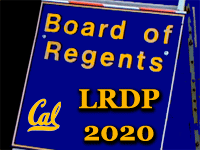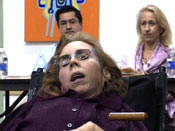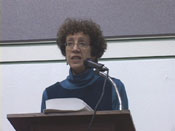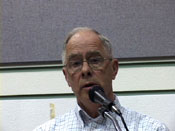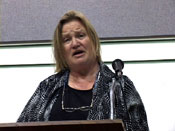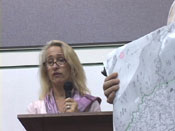
Between Reality and Wishful Thinking: University as a Neighbor Public Forum Parts 1 & 2
Between Reality and Wishful Thinking: The University as a Neighbor Public Forum
November 14, 2005
Panelists:
Wendy Alfsen (neighborhood perspective)
Jesse Arreguin (affordable housing, student concerns)
Zelda Bronstein (UC and the Berkeley General Plan)
Andy Katz (environmental issues)
Dean Metzger (the University and city finances and taxes)
Anne Wagley (historical overview of UCB growth)
Rob Wrenn (traffic and parking)Sponsored by: BLUE Berkeleyans for a Livable University Environment.
The following is the press release for this event
UC brings Berkeley world-class intellect and culture. And the University is the largest employer in town. But UC is also a major source of traffic and air pollution. The University is the largest landowner in Berkeley, but its property is exempt from municipal regulation. The University uses city services (sewer, police, fire) but is not required to pay taxes, resulting in a higher tax burden for those who do pay taxes. UC supplies only a fraction of the housing needed by its students.
In a secret 6-3 vote taken in May 2005, the City Council settled its lawsuit over projected UC development. What does the settlement mean for city services, city taxes and the quality of life in Berkeley?
The UC administration has plans for major campus expansion, with much of the new development targeted at areas west of campus in Berkeley’s downtown. The settlement of the City’s lawsuit mandated a new Downtown Plan.
How will that plan address UC impacts?
How will it affect downtown Berkeley?
How can we encourage the University to be a better neighbor?
What can city government do?
And what can Berkeley citizens do?Produced by Berkeley Citizen
Copyright 2005
All Labor DonatedThe Progran was broadcast on Berkeley Public Access Cable TV Channel 33
The University as a Neighbor Public Forum Part 2 Q&A
Audience participants included Lesley Emmington, Daniella Thompson, Janice Thomas, Clifford Fred, Sharon Hudson, Shan Masuda, Anne Wagley, Tom Mcbride, George Beier, Patti Dacey, Barbar Gilbert and Peter Mudniek.
DownTown Area Plan 2020 LRDP Regents
|
Council Silent on 'Nonaction' Against Cal
Devona Walker, Berkeley Daily Planet, February 20, 2002City Is Not Taking Action against University over Expansion Plans
In closed session yesterday the city sealed the lid on a possible lawsuit against University of California Berkeley's plan to put a parking structure and offices on Berkeley's southside. But perhaps more importantly, it sealed the details of that closed session meeting by further deciding not to report on it -- disallowing councilmembers to speak about what took place behind closed doors.
The proposed construction has been protested by residents living near the northeast quadrant of the campus, claiming the EIR originally drafted for the project failed to address important environmental impacts of the construction and the new buildings.
Marie Felde, director of media relations for UC Berkeley, was unavailable yesterday but in the past had denied deficiencies in the EIR. University officials extended the public comment period well beyond state requirements Felde said. Approximately ten minutes before closing those doors, Council heard from some 15 or so residents all pleading for the city to move forward with the lawsuit.
Local activist L A Wood stood before City Council and told them that if they did not vote to proceed with the lawsuit citizens would not only remember but would also make them regret their decision.
Worthington said Council's decision shields certain members from facing angry constituents who wanted them to take a stand against the university.
"With them choosing not to report out, I can't tell you how I voted or how anyone else voted without violating that decree. Some people on council don't want others to know how they voted," Worthington said. "The average citizen will not know how their representative votes but wealthy companies sure can."
Worthington said the law does not require the city to disclose what happens in closed discussion unless an action is taken but that it does not prevent Council from doing so either. He also stated that he has historically argued in favor of disclosing as much information as possible to no avail. "Council is not required to report what happens in closed session unless it takes action. We are not reporting on what happened in closed session today because no action was taken." Worthington pointed to a prior closed session meeting where a large corporation who had contributed to the re-election campaign of a councilmember was quoted in the Daily Planet as saying his matter was voted down unanimously. "Clearly someone went back and told him. So this large corporation is allowed access and the public isn't," Worthington said.
The City Attorney would not say whether this "nonaction" gives the city the option of continuing the suit later.
Town Prepares to Battle University over Growth Plans
Pam Reynolds, Berkeley Daily Planet, October 5, 2001University s Proposed Growth Troubles City's Residents
When Jim Sharp moved into his home 13 years ago, its location two blocks from the UC Berkeley campus was part of its charm. Times have changed. Now his house is only one block from campus, and he speaks of the "blight" that university expansion brings to his neighborhood.
Sharp has been one of the most vocal critics of UC Berkeley's plan to expand and renovate several buildings on the northeast corner of campus, called the Northeast Quadrant Science and Safety Project. At the urging of Sharp and other community members, the Berkeley City Council decided Thursday to hire a lawyer to advise them on challenging the university's draft Environmental Impact Report for the project.
The NEQSS project plans to replace seismically unstable Stanley Hall and Davis Hall North with larger facilities, and add a new building next to Soda Hall. The construction, planned for 2002 to 2005, would add 244,000 square feet and 400 new employees to the area. Community opponents to the project claimed that the draft EIR fails to address important environmental impacts of the construction and the new buildings.
Marie Felde, director of media relations for UC Berkeley, denied that the draft Environmental Impact Report is deficient in the areas suggested. "We have worked very hard to address the potential impacts that the community has raised," she said, "including extending the public comment period well beyond what is required by the state."
The new buildings will house offices, lab and teaching space, including portions of the new Institute for Bioengineering, Biotechnology and Quantitative Biomedical Research, a partnership with UC San Francisco, UC Santa Cruz, and corporations such as Chiron in Emeryville.
New labs cause concern
The fact that the buildings will house science facilities, especially state-of-the-art new biotech research labs, is a cause for concern for many residents. Pam Sihvola, co-chair of the Committee to Minimize Toxic Waste, cited concerns that the buildings are too near the Hayward Earthquake Fault, "There is a very, very real danger," she said, "I think the whole area should not be used for any kind of building and certainly not for operations using hazardous and radioactive materials."
L A Wood, a commissioner on the Community Environmental Advisory Commission, is convinced that the new buildings will house hazardous and radioactive experiments performed by the Lawrence Berkeley National Laboratory. He referred to a "stealth lab" of LBNL operations performed on campus that are not governed by university and state regulations, and expressed concern that LBNL would be "coming down to Stanley Hall, making a mega-radiation complex like you couldn't imagine." Wood wants the university to disclose exactly what the new facilities would be used for, how much space would be occupied by LBNL, and what chemicals and radioisotopes would be in use.
What Wood, Sihvola and others would really like to see is research labs using hazardous or radioactive materials relocated to remote facilities, away from urban and residential areas.
Only 9 percent LBNL on campus. Rich McClure, a Facilities Planner at Lawrence Berkeley National Lab said LBNL has no plans to have significant facilities in the new buildings. Currently 9 percent of lab space is on the university campus, mostly in Donner and Calvin Labs.
Many of the opponents of the northeast quadrant expansion were also involved in the outcry against LBNL's National Tritium Labeling Facility, which will close in December.
Another major concern for project opponents is the size of the new facilities, which some neighbors said will strain an area already suffering from traffic congestion and noise problems. Sharp said that one neighbor wears earplugs and earmuffs to cut out the noise of current construction projects on Hearst Avenue.
Mayor Shirley Dean noted that the NEQSS construction proposal is "one of the biggest projects that has come before the council, and there is rightfully some nervousness about it." "We need to be very, very careful," she said, "because of the size of this project, and because of things we hear are waiting around the corner."
One of those things is "Tidal Wave II," the influx of 4,000 more students plus associated faculty and staff the university expects to see in the coming decade.
University expansion has been a sore point in Berkeley for decades. Sharp, however, doesn't think this is just another one of the university's growing pains. "This is different," he said. "It's lots more industrial research and development, it's like part of the university morphing into an industrial park."
Wood agreed. "I believe what they want to build toward is more like a biotech industrial complex," he said, "I believe they've lost sight of the students."
Some call for legislative action. The expansion project has led some opponents to advocate that the city seek state legislative action to block further university growth, as was done in San Francisco.
That is something the city is talking about, Dean commented, but no action has been taken in that direction. "I think the problem is, the campus is maxed out - if it grows, the city shrinks."
"There are some people hoping the city of Berkeley would lead other cities, who are impacted by institutional growth," said Sharp, who supports legislative restrictions on university expansion. Sharp also suggested that the city needs to better monitor university impacts on city services, and reassess whether enough money is being collected for services the city provides for the campus. He proposed a neighborhood mitigation fund to compensate areas impacted by university growth, and more discussion of the livability of neighboring areas. "I'm hoping this is a wake-up call that we're hearing from the council," said Sharp, "but time will tell."
A spokesperson for the city attorney's office noted that the plan to hire outside counsel is still in its initial stages, and was unable to say who would be hired or what issues that person would be addressing.
Northeast Quadrant Science and Safety Project (NEQSS)
1990 Long Range Development Plan (LRDP)
Physical and Environmental Planning Office
1 A&E Building (1382)
University of California, Berkeley CA 94720-1382
Re: Northeast Quadrant Science and Safety Projects and 1990 Long Range Development Plan Amendment, Draft Environmental Report (June 2001) for the following Building Projects: Stanley Hall Replacement Building (SHRB), Davis Hall North Replacement Building (DHNRB), Soda Hall II New Development, Cory Hall Renovations, Navel Architecture Building (NAB) Seismic Retrofit, Davis Hall South (New Davis Hall) Seismic Retrofit and Lower Hearst Parking Structure. State Clearinghouse # 2001022038Dear Ms. Lawrence:
Thank you for the opportunity to make comments on the University of California’s Northeast Quadrant Science and Safety Project (NEQSS). It first should be noted that this project is comprised of several large projects and that each individual project should have its own environmental review. In fact, it appears that this project, NEQSS, is the largest project ever undertaken by the University, under a single construction initiative.
However, it seems as though this project is being purposefully fast tracked so as to bypass both the University’s New Century Plan (NCP) and the new Long Range Development Plan (LRDP) of the Lawrence Berkeley National Laboratory (LBNL). This results in a grossly incomplete NEQSS review, which fails to analyze or even recognize the fact that, geographically, LBNL and its chemical, radiological and nuclear labs constitute a major part of the University’s northeast quadrant.
Consequently, this current project should not proceed isolated from the University’s New Century Plan and LBNL’s LRDP because attempting to consider the NEQSS project separately from the UC’s NCP and LBNL’s LRDP would be improper project segmentation (“piecemealing”) in violation of both CEQA and the National Environmental Policy Act (NEPA). Having said this, please consider the following:
Geology, Soils and Seismicity
The majority of chemicals transported to the University’s Hazardous Waste Handling Facility are generated in the northeast part of the central campus, close to Stanley Hall. Hence, the northeast quadrant is the University’s Chemical Quadrant. This area, around Stanley Hall is already highly congested with a combination of pedestrians, campus vehicular traffic and bicyclists. Nearby academic and administrative buildings, which include classrooms and lecture halls filled with students, create a very high daytime population. This already existing large number of people using the area around Stanley Hall would increase both conflicts created by congestion and possible exposures to an accidental release of chemicals.
In 1994 the Stanley Hall site was part of an environmental evaluation for a replacement hazardous waste facility on the campus. In the review document (Draft Environmental Impact Report for the Environment, Health and Safety Replacement Facility, State Clearinghouse #93091039), it was stated that in the event of a major earthquake on the Hayward Fault, the building (Stanley Hall) could be subjected to violent ground shaking (p. 6-19). This is one of the central reasons why the Stanley Hall site was rejected as a viable alternate location.
The current NEQSS environmental review fails to acknowledge this very critical fact. The enclosed EIP Associates’ map clearly shows that portions of both the existing Stanley Hall, and Department of Energy (DOE)/ LBNL’s Donner Laboratory are within the bounds of the Alquist-Priolo Fault-Rupture Hazard Zone of the Hayward Fault. (See attachment 1).
The Alquist-Priolo Fault Zoning Act was adopted in 1973. The act states that “cities and counties (such as Berkeley and Alameda county) affected by zones must regulate certain development projects within the zones. They must withhold development permits for sites within the zones until geologic investigations demonstrate that the sites are not threatened by surface displacement from future faulting.” It appears that no such required geologic investigations were included in the draft NEQSS EIR.
The San Francisco Chronicle article (June 27, 2001) titled Shaky Ground, which describes the University’s plans regarding the 100 million dollar Memorial Stadium retrofit, states: “experts interviewed at the State Seismic Safety Commission and Division of Mines and Geology said they knew of no serious efforts to withstand the tremendous force of the earth ripping apart. No one knows how much the Hayward Fault would tear. The ground on one side of a fissure in the 1992 Landers quake in the Mojave Desert jumped 21 feet relative to the other side.”
A recent Daily Californian article (July 27, 2001) subtitled Volatile Chemicals, Delicate Light Fixtures Potential Hazards states the following: At UC Berkeley “labs compose thirty percent of the campus. In the Northridge Earthquake there was a lot of damage at Cal State Northridge...in the chemistry buildings, some of the chemicals reacted with each other and started fires.” Where in the draft EIR is the detailed review and hazard analysis for the inevitable earthquake, “the BIG ONE” on the Hayward Fault, and the evaluation relating to the potential for a chemical firestorm?
Stanley Hall (and Donner Laboratory next door) should be decommissioned and no replacement facilities should be located at the site given the potential for a catastrophic earthquake on the Hayward Fault. The impact of such an event would go far beyond the central campus and would be horrific enough to manage, without the added threat of chemical and radioactive releases from the proposed development and activities at Stanley Hall, other NEQSS building projects and existing central campus laboratory buildings.
Hazards and Hazardous Materials
During the 50 years of operations at Stanley Hall, (according to the draft EIR) radionuclides were used in its laboratories. The final EIR for NEQSS should list the inventory of all the radioisotopes and hazardous chemicals that have been used in Stanley Hall, during its life time, as well as all other buildings under consideration in the NEQSS project (i.e., Davis Hall North, Cory Hall, Soda Hall, Naval Architecture Building and Davis Hall South). In addition, a complete Hazardous Materials Work Plan should be provided for identifying the degree of contamination in the many ducts, fume hoods, glove boxes, and exhaust systems of the various laboratories as well as for the safe removal of the contaminated equipment. The Stanley Hall Replacement Building would also require the removal of 101,000 cubic yards of earth and Davis Hall another 66,000 cubic yards. The Hazardous Materials Work Plan and site characterizations should include comprehensive soil and groundwater testing to determine the degree of contamination at all NEQSS sites. Disposal options should also be outlined for each site.
The Work Plan should require agency (California Department of Health Services and California Department of Toxic Substances Control) and public review prior to the commencement of any demolition. As stated above, the area around Stanley Hall is already highly congested. From a transportation point of view, the movement of hazardous and radioactive waste is problematic given that the proposed Stanley Hall is located next to the East entrance of the central campus and has inferior transit accessibility. The draft EIR fails to evaluate the many problems related to the movement of hazardous and radioactive materials and waste to and from the Stanley Hall area.
The proposed replacement of Stanley Hall is about 10 stories high, plus an additional two stories for cooling towers. At 285,000 square feet, it is more than 4 times the size of the existing building. This large increase in size will also mean increases in the use and storage of hazardous chemicals, radionuclides and nuclear materials (sources) at the site. The final EIR should list the inventory of all the radioisotopes and hazardous chemicals proposed to be used and stored in the new Stanley Hall as well as in all the other buildings under consideration in the NEQSS development.
It should be noted that the Stanley Hall is located next door to DOE/LBNL’s Donner Laboratory and close to the Melvin Calvin Laboratory, all of which use radioactive materials such as: Tritium (H-3), Carbon-14, Phosphorus-32, Sulfur-35, and Iodine-125, etc. as part of their research work. The draft EIR does not describe methods for capturing radionuclides not consumed in the experiments in laboratories at Stanley Hall, Davis Hall North, etc. The draft NEQSS EIR also fails to address the cumulative impacts from all the chemicals and radioisotopes used at the various existing and proposed campus laboratories within the northeast Chemical Quadrant. A serious shortcoming of this draft EIR is its complete failure to address issues related to radioactive waste generation, treatment, storage, emissions and disposal.
The draft EIR fails to describe in detail any of the research activities proposed for the first three floors (basement level) of Stanley Hall reserved for “imaging” and NMR’s. What types of imaging are involved in advanced medical imaging technologies? Do they include positron emission tomography, single photon emission computed tomography, nuclear magnetic resonance imaging, gamma irradiators, and cyclotrons? How many curies of Cs-137 and Co-60 will be located onsite as sources? How and where will the gamma radiation field be measured? What other radiological activities will be carried out at the proposed Stanley Hall and other NEQSS project sites? How and where are the emissions going to be monitored?
Where is the evaluation of the potential environmental impacts from the cooling towers on the Stanley Hall rooftop? Will LBNL or any biotech corporation/business/institution occupy research space at this new building or other NEQSS project buildings? If so, then who and what percentage of these new buildings will they occupy/lease? Will there be corporate sponsorship, i.e. such as the recent NOVARTIS contract with UCB’s College of Natural Resources?
Within the proposed activities at Stanley Hall is provision for animal research. The draft EIR claims that animals will be held only for short-term (p. 2-16) What does this mean? Are the animals going to be killed within 24 hours after experimentation? How are they going to be killed and how will the carcasses be disposed of? As hazardous waste or radioactive waste? How many animals are going to be processed (used in experiments) in a year? Will there be independent (of all users) monitoring of animal research to ensure humane treatment of laboratory animals?
The draft EIR states that much of the hazardous materials handled at Stanley and Davis Hall North are consumed through use. (p. 3.5-7) This appears not to be factual because much of the hazardous and radioactive materials used in lab activities will actually escape these buildings through fume hoods, which are designed to keep poisonous fumes from intoxicating lab researchers (students). This will have a serious impact on the local campus environment, Girton Hall Childcare Center, Stern Hall, other student dormitories and residential neighborhoods, all of which the draft EIR fails to address.
According to the October 1,1997 Contract between the United States of America and the Regents of the University of California of the Management of LBNL, Appendix I, LBNL currently occupies 105, 503 square feet of space in fifteen (15) various central Berkeley campus buildings (See attachment 2). Most of these labs are positioned in the Northeast Quadrant. There is no oversight by the University’s Office of Radiation Safety (ORS) or the State Department of Health Services (DHS) at any of these DOE/LBNL occupied/leased laboratories. These on campus laboratories have no restrictions regarding inventory and/or use of radioactive materials.
The impact of these DOE/LBNL activities have been overlooked and consequently excluded from all University of California, Berkeley generated campus environmental evaluations such as this draft EIR currently under review. Therefore, all labs on campus, whether University or LBNL occupied should be brought under the regulatory jurisdiction and oversight of the ORS and DHS. This would enhance both the health and safety of students and nearby residents. It would also provide a much needed campus wide comprehensive inventory of chemicals and radionuclides which, for the first time would identify and factor in both LBNL’s and the University’s labs activities and their cumulative health and safety risks
.
Recommendations
The proximity of the proposed NEQSS project to an active earthquake fault, the Hayward Fault, has the great potential to cause hazardous and radioactive materials releases from existing and proposed buildings, a chemical/radioactive firestorm in an already densely populated urban center. We strongly recommend that no buildings be constructed along the Alquist-Priolo Hazard Rupture Zone, where a portion of the Stanley Hall is located.
This northeast corner of the campus should be dedicated as an open green space. This would relieve congestion and improve the area’s air quality by reducing the chemical inventory and chemical emissions in this quadrant, thus, minimizing risks to students and neighbors. The NEQSS project should not be approved as proposed, and no further evaluations should be conducted on these building projects outside the context of the LBNL Long-Range Development Plan.
Sincerely,Pamela Sihvola, Co-Chair Committee to Minimize Toxic Waste
L A Wood, Community Environmental Advisory Commission*
*For identification onlycc: Gray Davis, Governor, State of California
Steve Arthur, Acting Director, California Department of Conservation
James Davis, State Geologist, Division of Mines and Geology
Weldon Rucker, City Manager, City of Berkeley
Mayor and Members of the Berkeley City Council
Attachments:
1. Alquist-Priolo Fault-Rupture Hazard Zone Map (EIP)
2. Appendix I, USA and U.C. Regents 1997 Contract of the Management of LBNL2020 Long Range Development Plan for the University of California, Berkeley
Regents of the University of CaliforniaDate: January 18, 2005 Time: 11:00 a.m.
Location: UCSF–Laurel Heights
3333 California Street, San Francisco
Agenda–Open Session & Public Comment Period (20 minutes)
(A 30 minute video recording of the City of Berkeley Press Conference and Public Comments)Office of the President
TO THE MEMBERS OF THE COMMITTEE ON GROUNDS AND BUILDINGS:
ACTION ITEM
For the Meeting of January 18, 2005
CERTIFICATION OF THE ENVIRONMENTAL IMPACT REPORT AND APPROVAL
OF THE 2020 LONG RANGE DEVELOPMENT PLAN, BERKELEY CAMPUS
EXECUTIVE SUMMARY
Campus: Berkeley
Project: 2020 Long Range Development Plan
Proposed Action: Certify EIR and approve the LRDP
Previous Action: In May 1990, The Regents approved the 1990 Long Range Development Plan and EIR. In January 2002, The Regents amended the LRDP to add 325,000 gsf for the Northeast Quadrant Seismic and Safety Projects.
Project Summary: The 2020 LRDP projects a two-semester average enrollment of 33,450 by 2020-21 (an increase of 1,650 over the 2001-02 EIR base year) and summer session enrollment of 17,000. Faculty and staff are projected to increase to 15,810 (an increase of 2,870 over the 2001-02 EIR base year). Visitors and vendors are estimated at 2,000 by 2020. Building space is projected to increase to 14,307,100 gsf by 2020-21(a 2,200,000 gsf increase over 2001-02 EIR base year). Housing is estimated to increase to 10,790 beds (a 2,600-bed increase over 2001-02). The LRDP gives academic facilities priority to be located in the Campus Park rather than the Adjacent Blocks, Hill Campus, or Southside. The LRDP also identifies design guidelines for the Campus Park to maintain the classical core, natural riparian areas, and formal open space areas.
Issues: The EIR identified some significant unavoidable impacts. Key public concerns were proposed faculty housing in the Hill Campus area, expansion of University parking, and fiscal impacts to the City of Berkeley.
COMMITTEE ON -2- 112
GROUNDS AND BUILDINGS
January 18, 2005
RECOMMENDATION
The President recommends that, upon review and consideration of the attached Environmental
Impact Report, the Committee on Grounds and Buildings recommend that The Regents:
(1) Certify the EIR for the UC Berkeley 2020 Long Range Development Plan.
(2) Adopt the attached Mitigation Monitoring Program for the Final EIR
(3) Adopt the Statement of Overriding Considerations included in the Findings.
(4) Adopt the attached Findings pursuant to the California Environmental Quality Act.
(5) Adopt the 2020 Long Range Development Plan, Berkeley campus.
BACKGROUND
The 2020 Long Range Development Plan for UC Berkeley provides a framework for land use and capital investment to meet the academic goals and objectives of UC Berkeley through the year 2020. It describes both the scope and distribution of capital investment anticipated within this time frame, as well as policies to guide the location, scale, and design of individual projects. The 2020 LRDP does not commit the University to any specific individual project but rather provides a strategic context and procedures for decisions on those projects. The 2020 LRDP is not a separate document, but is fully contained in Chapter 3.1 of the LRDP EIR. It is a fundamental principle at UC Berkeley that its capital investment strategy should align with and promote the academic goals of the campus. Toward this end, the Chancellor formed a campus committee in fall 2000 to prepare a Strategic Academic Plan, which was completed in 2002. The scope of the Strategic Academic Plan is much broader than the 2020 LRDP, but many of its provisions listed below have significant implications for land use and capital investment and serve as a foundation for the objectives of the 2020 LRDP. Integrate Research and Education Research is fundamental to the educational mission.
As a research University, UC Berkeley strives to provide its students with a unique experience, one in which critical inquiry, analysis, and discovery are integral to the coursework. Students expect to play an active role in research, under the guidance of faculty who are themselves engaged in creating, not merely imparting, new knowledge. The integration of research-based learning into undergraduate education is a goal of the campus Strategic Academic Plan. In order to achieve it, the campus must expand the scope of its research programs to accommodate more direct, mentored participation by undergraduates and must also provide adequate and suitable space to house those programs. The 2020 LRDP describes the scale of capital investment required to accommodate recent and future expansion of the education and research programs of the campus.
All Rights Reserved

